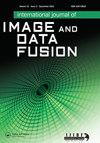Research on multi-source remote sensing image registration technology based on Baker mapping
IF 1.8
Q3 REMOTE SENSING
International Journal of Image and Data Fusion
Pub Date : 2023-11-09
DOI:10.1080/19479832.2023.2278671
引用次数: 0
Abstract
ABSTRACTTo address the issues of inaccurate estimation of registration parameters and high mismatch rate in feature based remote sensing image registration, a registration method based on global feature triangle similarity is proposed. This method utilizes the similarity principle of feature triangles to evaluate the global geometric similarity of matching feature points to eliminate mismatched points. In addition, due to the sensitivity of phase information in the frequency domain to spatial transformations and structural differences, as well as its robustness to lighting and noise, a phase structure consistency measurement method is proposed for developing feature point position adjustment strategies. The results indicate that the registration method proposed by the research institute achieved the lowest RMSE with a size of 1.51. In terms of IRMSE indicators, compared to the RANSAC measurement model, the PH SSIM measurement model has a mean decrease of 0.253. This indicates that the improved registration model proposed in the study has advantages in improving registration accuracy. The innovation of this study lies in constructing a matching feature point evaluation model to eliminate mismatched points, and proposing a remote sensing image registration method based on mismatch point removal and feature point position adjustment.KEYWORDS: Baker mappingregistration accuracymisalignment pointsfeature pointsRMSEPH-SSIM Disclosure statementNo potential conflict of interest was reported by the author(s).Additional informationFundingThe research is supported by: Scientific Research and Innovation Team of Chongqing Youth Vocational & Technical College, Enterprise Software Application Digital Transformation Technology Service Team (No., CQYFUTD202207).基于Baker映射的多源遥感图像配准技术研究
摘要针对基于特征的遥感图像配准中配准参数估计不准确和配错率高的问题,提出了一种基于全局特征三角形相似度的配准方法。该方法利用特征三角形的相似原理对匹配特征点的全局几何相似度进行评价,消除不匹配点。此外,由于频域相位信息对空间变换和结构差异的敏感性以及对光照和噪声的鲁棒性,提出了一种相位结构一致性测量方法,用于制定特征点位置调整策略。结果表明,该配准方法的均方根误差最低,为1.51。在IRMSE指标方面,与RANSAC测量模型相比,PH SSIM测量模型平均减小了0.253。这表明本文提出的改进配准模型在提高配准精度方面具有优势。本研究的创新点在于构建匹配特征点评价模型来消除不匹配点,并提出了一种基于不匹配点去除和特征点位置调整的遥感图像配准方法。关键词:Baker制图配准精度不对中点特征点rmseph - ssim披露声明作者未报告潜在利益冲突。本研究由重庆青年职业技术学院科研创新团队、企业软件应用数字化转型技术服务团队(重庆青年职业技术学院)资助。CQYFUTD202207)。
本文章由计算机程序翻译,如有差异,请以英文原文为准。
求助全文
约1分钟内获得全文
求助全文
来源期刊

International Journal of Image and Data Fusion
REMOTE SENSING-
CiteScore
5.00
自引率
0.00%
发文量
10
期刊介绍:
International Journal of Image and Data Fusion provides a single source of information for all aspects of image and data fusion methodologies, developments, techniques and applications. Image and data fusion techniques are important for combining the many sources of satellite, airborne and ground based imaging systems, and integrating these with other related data sets for enhanced information extraction and decision making. Image and data fusion aims at the integration of multi-sensor, multi-temporal, multi-resolution and multi-platform image data, together with geospatial data, GIS, in-situ, and other statistical data sets for improved information extraction, as well as to increase the reliability of the information. This leads to more accurate information that provides for robust operational performance, i.e. increased confidence, reduced ambiguity and improved classification enabling evidence based management. The journal welcomes original research papers, review papers, shorter letters, technical articles, book reviews and conference reports in all areas of image and data fusion including, but not limited to, the following aspects and topics: • Automatic registration/geometric aspects of fusing images with different spatial, spectral, temporal resolutions; phase information; or acquired in different modes • Pixel, feature and decision level fusion algorithms and methodologies • Data Assimilation: fusing data with models • Multi-source classification and information extraction • Integration of satellite, airborne and terrestrial sensor systems • Fusing temporal data sets for change detection studies (e.g. for Land Cover/Land Use Change studies) • Image and data mining from multi-platform, multi-source, multi-scale, multi-temporal data sets (e.g. geometric information, topological information, statistical information, etc.).
 求助内容:
求助内容: 应助结果提醒方式:
应助结果提醒方式:


